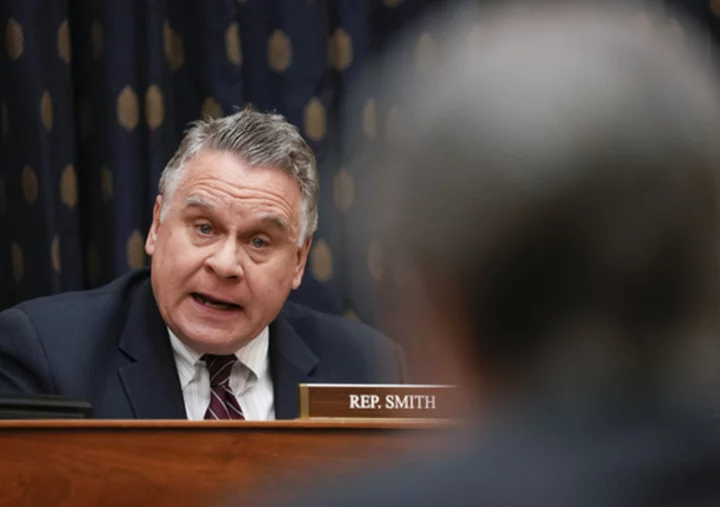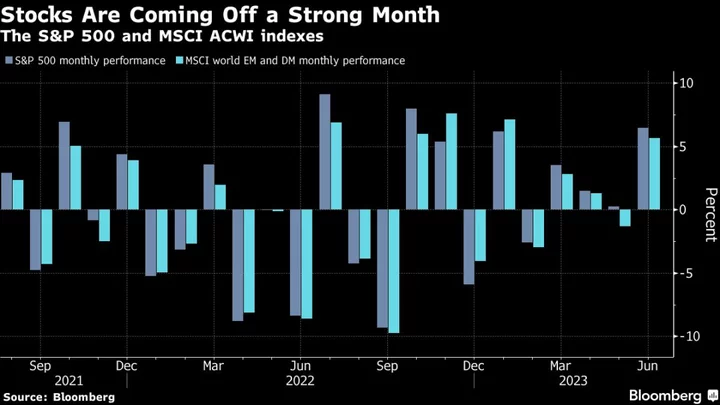Chile’s central bank slowed the pace of its easing cycle with an interest rate cut of 75 basis points and signaled that future reductions will likely continue at that pace as inflation heads toward target.
Policymakers led by Rosanna Costa voted unanimously to cut borrowing costs to 9.5% late on Tuesday, as expected by 13 of 22 analysts in a Bloomberg survey. The nine others forecast a second straight cut of 100 basis points.
In an accompanying statement, board members wrote the economy was developing in line with expectations and that inflation should slow to the 3% target in the second half of next year. As the same time, they said future rate moves would reflect incoming data and the outlook for price growth. The bank has indicated borrowing costs should end the year between 7.75% and 8%.
Read more: Chile Central Bank VP Says Outlook Is Unaltered by Currency Drop
“In the short term the MPR will continue on the path outlined in the previous meeting,” central bankers wrote regarding the key rate. “The magnitude and timing of the process of MPR reductions will take into account the evolution of the macroeconomic scenario and its implications for the inflation trajectory.”
Chile held its key rate at an over two-decade high for almost a year, damping investment and quashing a consumer spending boom. Annual inflation is now slowing toward target as the economy stagnates. At the same time, policymakers are cautiously monitoring possible price pressures from a weaker peso and recent local floods, as well as isolated signs of a pickup in growth.
What Bloomberg Economics Says
“The Chilean central bank’s rate cut on Tuesday shows policymakers are marching along as planned. Forward guidance pointed to two more reductions of 75 basis points this year and smaller cuts in 2024. We expect revised central bank projections and the updated policy outlook in Wednesday’s quarterly report to adopt this view.”
— Felipe Hernandez, Latin America economist
— Click here for full report
Chile, Brazil, Uruguay and Paraguay are among the first South American countries that have started to cut interest rates, reaping the benefits of early and aggressive monetary tightening campaigns. Economists expect Peru and Colombia to follow suit in the coming months.
More Cautious
Amid Chile’s weaker economy, a few key readings have surprised on the upside. Gross domestic product contracted by 0.3% in the second quarter, less than forecast by analysts, while activity unexpectedly increased in July.
Activity and demand have evolved in line with expectations, board members wrote. Private consumption has stabilized and investment has shown some improvement in machinery and equipment, they wrote.
“The central bank is staying on its path,” Sebastian Diaz, an economist at Pacifico Research in Santiago, said regarding monetary policy. “There will be some dependency on data, on if there are surprises in inflation or economic activity, the latter of which has been volatile because of mining.”
Regarding the depreciation of the peso, board members wrote that recent declines can be “explained both by changes in the interest rate differential with other countries and by greater risk aversion in global markets.”
The peso has slid 5.2% against the dollar since the prior rate decision on July 28. A weaker currency usually fans inflation by making imports costlier.
Annual inflation slowed to 6.5% in July, above the 6.4% median estimate, but less than half the 14.1% peak hit a year ago. Economists and traders surveyed by the monetary authority see price growth at target in two years.
Both headline and core consumer price readings remain high despite continued declines, policymakers wrote in their statement. Services inflation in particular has eased more gradually, they wrote.
Chile’s central bank will provide more details on its economic outlook — including projections for GDP and inflation and the expected path for borrowing costs — in its quarterly monetary policy report on Wednesday.
“The central bank reads more cautious about the inflation prospects ahead compared to the previous meeting,” Credicorp Capital economists Samuel Carrasco and Daniel Loveland wrote in a note. “Given the current set of information the central bank would opt for the 8% level by year-end.”
--With assistance from Rafael Gayol and Giovanna Serafim.
(Re-casts story, adds economist comments starting in sixth paragraph)









